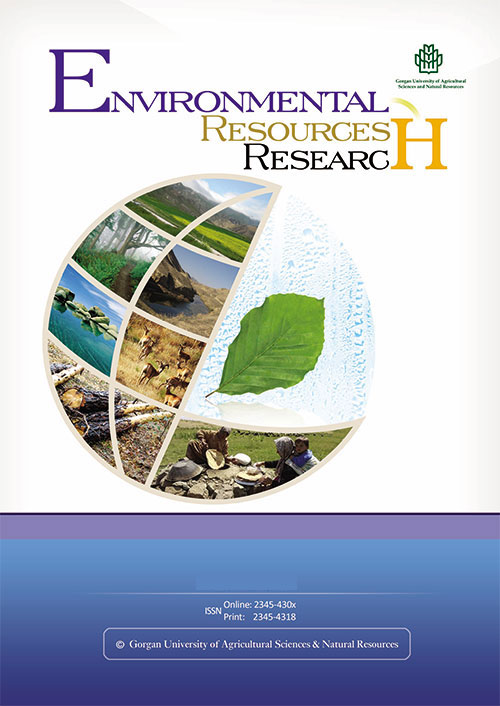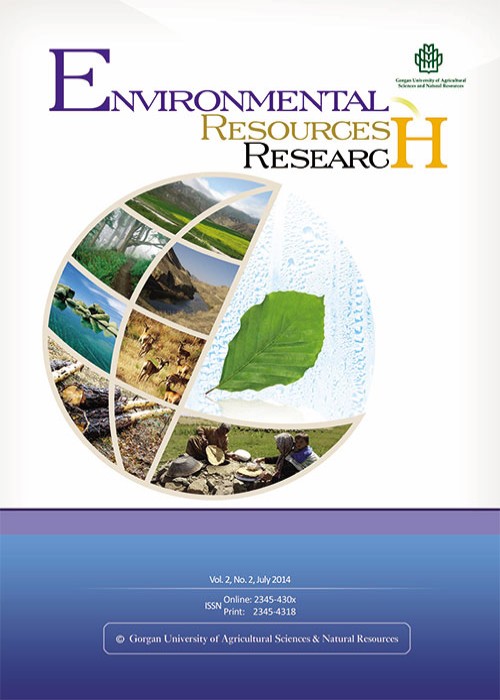فهرست مطالب

Journal of Environmental Resources Research
Volume:8 Issue: 1, Summer-Autumn 2020
- تاریخ انتشار: 1399/06/26
- تعداد عناوین: 7
-
-
Pages 1-10
The invertebrates are one of the most important terrestrial fauna and freshwater taxa.Benthic macroinvertebrates include aquatic insects and spiders, mites, crustaceans, andspecies of mollusks and worms that are aquatic in their immature stages and terrestrial intheir adult stage. Jajrud River originates from the Alborz Mountains and is a source ofdrinking water for people in eastern part of Tehran and the surrounding villages. For thetaxonomic identification of benthic macroinvertebrates, five stations downstream of Jajrudwere used. A Surber sampler device was used for sampling with dimensions 30 × 30 cmand mesh size of 250 microns in all four seasons of the year 2013 with three repetitions ateach station. In total, five orders (Ephemeroptera, Coleoptera, Diptera, Trichoptera, andOligochaeta) and 13 families of benthic macroinvertebrates were identified. In all stations,the family Baetidae (Baetis sp .) belonging to the order Ephemeroptera had the highestabundance, and seasonally the highest abundance was detected in autumn, winter, summer,and spring respectively. After the identification of benthic macroinvertebrates, five bioticindices including EPT, HFBI, SIGNAL, NJIS, and MMIF were calculated for water qualityassessment in downstream of the Jajrud River. Regarding the results of the biotic indices, itcan be said that the water quality of downstream of Jajrud River is not favorable. Therefore,appropriate management measures should be taken to improve river water quality.
Keywords: Downstream Jajrud, Benthic Macroinvertebrates, Sampling, Surber Sampler, Biotic Index -
Pages 11-24
Identifying suitable models for estimating soil erosion is one of the most importantissues facing decision makers and managers in comprehensive planning and management ofsoil and water. In this research, with the purpose of estimating soil erosion in LorestanProvince, the conventional SLEMSA method was jointly used with OWA (orderedweighted averaging) multi-criteria evaluation method. The results showed that in theSLEMSA model, erosion classes with very low and very high erosion rates with an area of16334 and 167 km2, covered the largest (58.7%) and the smallest areas of the region (0.6%),respectively. In the OWA method, on average, 63.67% of the area covering 18007 km2 waslocated in a very low erosion class, while the very high erosion class with an area of 956.5km2, comprised 5.85% of the study area. The results of this research showed that besidesusing the SLEMSA model, the OWA method introducing a decision environment with riskand uncertainties can be used to estimate erosion, and its output can lead to a relativelyprecise assessment of the soil erosion in a short time and at a low cost for a vast area likeLorestan Province.
Keywords: Soil erosion, Erodibility, Topography, Vegetation, Ordered weight -
Pages 25-40
One of the most commonly used statistical models for characterizing the variations of tree diameter at breast height is Weibull distribution. The usual approach for estimating parameters of a statistical model is the maximum likelihood estimation (likelihood method). Usually, this works based on iterative algorithms such as Newton-Raphson. However, the efficiency of the likelihood method is not guaranteed since there is no assurance that the Newton-Raphson method for maximizing the log-likelihood function will converge. In such cases, one option is to use a better estimation approach. In this study, several methods were compared for estimating the parameters of two- and three-parameter Weibull distributions. We applied ten methods for two-parameter and twelve methods for three-parameter cases. The data set was collected from natural beech dominated forest in northern Iran. The results demonstrated that among the estimators investigated for two-parameter Weibull distribution, the percentile method outperformed other competitors. In contrast, for three-parameter Weibull distribution, the trimmed L-moment (TL-moment) method and the modified method of moments (type I and type II) outperformed other competitors in terms of Cramer Von-Mises criterion and Kolmogorov-Smirnov criterion, respectively.
Keywords: Least square method, Method of maximum product spacings, TL-moment, Weibull distribution, Weighted maximum likelihood estimator -
Pages 41-54
Contamination of water resources with toxic elements is one of the challenges of thetoday's world. In this research, application of Goethite nanoparticles in removingcontamination of arsenic and mercury from synthetic wastewater in a batch mode isinvestigated. For this purpose, the effect of different factors including pH, adsorbent dosage,contact time, and initial concentration on the extent of adsorption of arsenic and mercury bythe Goethite nanoparticles was studied. The maximum extent of arsenic adsorption in thisstudy being 99.95% occurred at pH=4, adsorbent dose of 4 g/L, initial concentration of 10mg/L and after 120 min from the beginning of the reaction. Examination of the effect of pHon the extent of mercury adsorption showed that the maximum mercury adsorption occuredat pH=8. Furthermore, the adsorbent dose of 3 g/L with initial concentration of10 mg/L, following 30 min from the beginning of the reaction caused mercury removalfrom aqueous solution by up to 72.45%. Investigation of the equation of isotherms ofLangmuir and Freundlich adsorption for arsenic and mercury shows better congruence ofthese ions with Langmuir isotherms. The kinetic studies showed that the As and Hgadsorption mechanism was well described by pseudo-second-order kinetic model. Thisstudy indicates that Goethite nanoparticles could be used for removing the toxic arsenic andmercury ions from wastewater.
Keywords: Goethite nanoparticles, Arsenic, Mercury, Water Pollution, Adsorption -
Pages 55-63
Plant Genetic Resources (PGRs) are one of the most valuable natural resources of anycountry. Biotechnology through genetic engineering of plants and the creation of new plantvarieties can increase the value of these resources. Different technical and legalmechanisms such as ex situ/in situ collection of PGRs, and Intellectual Property Rights(IPRs) indicate also an international institutional effort for sustainable use of biodiversity.Investigating international developments in the fields of exploitation and conservation ofPGRs is therefore essential. The main purpose of this manuscript is to explore criteria thatinternational legal instruments use for creating an appropriate interaction betweenconservation and exploitation of PGRs. These instruments have been especially developedin the two systems of international environmental law and intellectual property rights.Based on a descriptive analysis method, this research attempted to examine the provisionsof these two legal instruments. Research findings indicate that intellectual property rightsencourages the creation and development of green technologies, especially agrobiotechnology and protects Traditional Knowledge (TK) associated with PGRs as anappropriate tool for the sustainable exploitation of PGRs when implemented in aresponsible manner. International environmental law paves also the way for biodiversityconservation through creation of binding and non-binding obligations for preservinggenetic diversity on the planet. Sustainable conservation of PGRs requires an appropriateinteraction between the two legal systems.
Keywords: Precautionary principle, State sovereignty principle, Traditional knowledge, Geographical indications, Breeders' rights -
Pages 65-82
The surface adsorption of heavy metals in effluents with nanoparticles is today asuitable method for effluents treatment. In the present study, lignocellulose nano-fibers(LCNFs) were used as natural adsorbent for lead adsorption. The aim was to evaluate leadadsorption using adsorption isotherms, kinetics and thermodynamics. Fourier TransformInfrared Spectroscopy (FT-IR) and Transmission Electron Microscopy (TEM) wereemployed to determine the chemical and structural properties of this adsorbent. To studythe adsorption isotherm, two-parameter models of Langmuir, Freundlich, Temkin, andDubinin–Radushkevich were compared and three-parameter models of Redlich-Petersonand Sips and maximum correlation coefficient (R2) were selected as the best isothermmodel for lead adsorption, which was obtained for the Langmuir model at 0.9997 and theRedlich-Peterson model at 0.9338. Therefore, the data were consistent with both models butwere better described by the Langmuir model, indicating homogeneity of the adsorbentsurface. In addition, reaction kinetic models, including pseudo-zero-order, pseudo-firstorder, pseudo-second-order and pseudo-third-order as well as the diffusion kinetic modelsincluding intra-particle diffusion and Elovich were investigated for adsorption reaction. Themaximum correlation coefficient (R2=1) was related to the pseudo-second-order model;therefore, the lead adsorption by LCNFs was of a chemical type. The results obtained fromthe calculation of thermodynamic parameters such as Gibbs free energy (ΔG), enthalpy(ΔH◦), and entropy (ΔS◦) respectively showed spontaneity, exothermicity, and increasedirregularities of the reaction. This study showed that LCNF is suitable for the adsorption oflead and as such could be used as a cost-effective adsorbent in the process of industrialwastewater treatment.
Keywords: Adsorption, isotherm, kinetics, lignocellulose Nano-fibers (LCNFs), lead -
Pages 83-95
Four heavy metals were measured in forty-nine topsoil samples collected fromagricultural areas in Siakh-Darengoun, Iran. The goals were to investigate soil spatialdistribution patterns of metals; their potential ecological risk; and sources. The Hakansonpotential ecological risk index and index of geo-accumulation (Igeo) were used forevaluating the condition of soil heavy metal enrichment and the extent of potentialecological risk. Results demonstrated that the mean concentrations in the agricultural soilswere 2.23 mg/kg for Cd, 5.3 mg/kg for Cu, 38.002 mg/kg for Pb, and 13.84 mg/kg for Zn.The average concentrations of Cd and Pb in the agricultural soils were higher than averageworldwide soils and for Cu and Zn, values were lower than average worldwide soils. Thespatial mapping of the distribution of heavy metals produced by kriging interpolationshowed similar patterns for all heavy metals, and higher concentrations of all heavy metalswere observed in the western and southern parts of the study area. Our findingsdemonstrated that in the Siakh-Darengoun plain, natural sources affect the levels of Cu andZn, however, anthropogenic sources such as chemical fertilizers, especially phosphatefertilizers could be the major sources of Cd and Pb. Hossain Abad agro industry in the westof the study area can be considered as one of the most important heavy metal sources. Thegeo-accumulation index classified Cu and Zn into no pollution levels, Cd and Pb intounpolluted to moderately polluted level. Cd produced serious ecological risk in agriculturalsoils and was the main pollutant, while the Cu, Pb and Zn had low ecological risk.Comprehensive potential ecological risk indexes of all metals showed that the soils in SiakhDarengoun were suffering from high level of ecological risk.
Keywords: Spatial Distribution, Geostatistics, Ecological Risk, Heavy Metals, ChemicalFertilizers


